概述
上一篇我们重点介绍了组件的创建、注册和使用,熟练这几个步骤将有助于深入组件的开发。另外,在子组件中定义props,可以让父组件的数据传递下来,这就好比子组件告诉父组件:“嘿,老哥,我开通了一个驿站,你把东西放到驿站我就可以拿到了。”
今天我们将着重介绍slot和父子组件之间的访问和通信,slot是一个非常有用的东西,它相当于一个内容插槽,它是我们重用组件的基础。Vue的事件系统独立于原生的DOM事件,它用于组件之间的通信。
本文的主要内容如下:
- 组件的编译作用域
- 在组件template中使用<slot>标签作为内容插槽
- 使用$children, $refs, $parent 实现父子组件之间的实例访问
- 在子组件中,使用$dispatch向父组件派发事件;在父组件中,使用$broadcast向子组件传播事件
- 结合这些基础知识,我们一步一步实现一个CURD的示例
Demo和源代码已放到GitHub,如果您觉得本篇内容不错,请点个赞,或在GitHub上加个星星!
编译作用域
尽管使用组件就像使用一般的HTML元素一样,但它毕竟不是标准的HTML元素,为了让浏览器能够识别它,组件会被解析为标准的HTML片段,然后将组件的标签替换为该HTML片段。
<div id="app">
<my-component>
</my-component>
</div>
<template id="myComponent">
<div>
<h2>{{ msg }}</h2>
<button v-on:click="showMsg">Show Message</button>
</div>
</template>
<script src="js/vue.js"></script>
<script>
new Vue({
el: ‘#app’,
components: {
‘my-component’: {
template: ‘#myComponent’,
data: function() {
return {
msg: ‘This is a component!’
}
},
methods: {
showMsg: function() {
alert(this.msg)
}
}
}
}
})
这段代码定义了一个my-component组件,<my-component><my-component>不是标准的HTML元素,浏览器是不理解这个元素的。
那么Vue是如何让浏览器理解<my-component><my-component>标签的呢?(下图是我个人的理解)
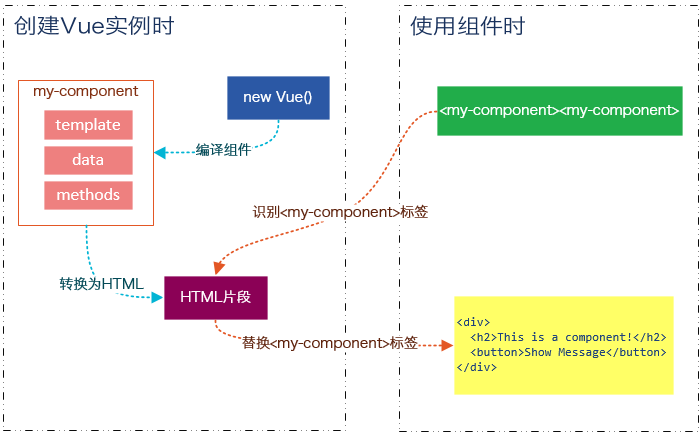
在创建一个Vue实例时,除了将它挂载到某个HTML元素下,还要编译组件,将组件转换为HTML片段。
除此之外,Vue实例还会识别其所挂载的元素下的<my-component>标签,然后将<my-component>标签替换为HTML片段。
实际上浏览器仍然是不理解<my-component>标签的,我们可以通过查看源码了解到这一点。
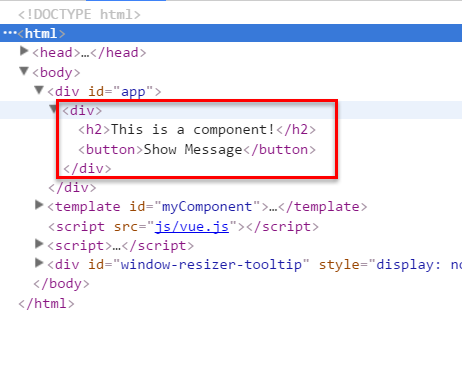
组件在使用前,经过编译已经被转换为HTML片段了,组件是有一个作用域的,那么组件的作用域是什么呢?
你可以将它理解为组件模板包含的HTML片段,组件模板内容之外就不是组件的作用域了。
例如,my-component组件的作用域只是下面这个小片段。

组件的模板是在其作用域内编译的,那么组件选项对象中的数据也应该是在组件模板中使用的。
考虑下面的代码,在Vue实例和组件的data选项中分别追加一个display属性:
new Vue({
el: ‘#app’,
data: {
display: true
},
components: {
‘my-component’: {
template: ‘#myComponent’,
data: function() {
return {
msg: ‘This is a component!’,
display: false
}
},
methods: {
showMsg: function() {
alert(this.msg)
}
}
}
}
})
然后在my-component标签上使用指令v-show=”display”,这个display数据是来源于Vue实例,还是my-component组件呢?
<div id="app">
<my-component v-show="display">
</my-component>
</div>
答案是Vue实例。
至此,我们应该认识到组件的作用域是独立的:
父组件模板的内容在父组件作用域内编译;子组件模板的内容在子组件作用域内编译
通俗地讲,在子组件中定义的数据,只能用在子组件的模板。在父组件中定义的数据,只能用在父组件的模板。如果父组件的数据要在子组件中使用,则需要子组件定义props。
使用Slot
为了让组件可以组合,我们需要一种方式来混合父组件的内容与子组件自己的模板。这个处理称为内容分发,Vue.js 实现了一个内容分发 API,使用特殊的 <slot> 元素作为原始内容的插槽。
如果不理解这段话,可以先跳过,你只要知道<slot>元素是一个内容插槽。
单个Slot
下面的代码在定义my-component组件的模板时,指定了一个<slot></slot>元素。
<div id="app">
<my-component>
<h1>Hello Vue.js!</h1>
</my-component>
<my-component>
</my-component>
</div>
<template id="myComponent">
<div class="content">
<h2>This is a component!</h2>
<slot>如果没有分发内容,则显示slot中的内容</slot>
<p>Say something…</p>
</div>
</template>
<script src="js/vue.js"></script>
<script>
Vue.component(‘my-component’, {
template: ‘#myComponent’
})
new Vue({
el: ‘#app’
})
</script>
这段代码运行结果如下:
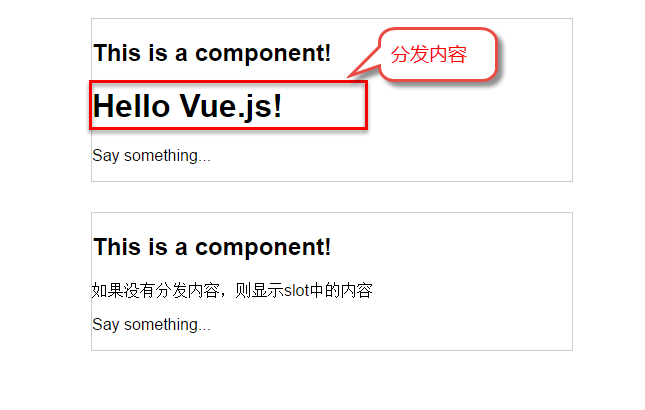
第一个<my-component>标签有一段分发内容<h1>Hello Vue.js!</h1>,渲染组件时显示了这段内容。
第二个<my-component>标签则没有,渲染组件时则显示了slot标签中的内容。
指定名称的slot
上面这个示例是一个匿名slot,它只能表示一个插槽。如果需要多个内容插槽,则可以为slot元素指定name属性。
多个slot一起使用时,会非常有用。例如,对话框是HTML常用的一种交互方式。
在不同的运用场景下,对话框的头部、主体内容、底部可能是不一样的。
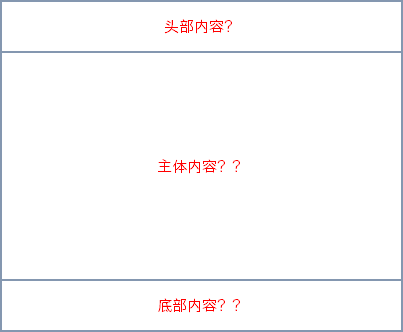
这时,使用不同名称的slot就能轻易解决这个问题了。
<template id="dialog-template">
<div class="dialogs">
<div class="dialog" v-bind:class="{ ‘dialog-active’: show }">
<div class="dialog-content">
<div class="close rotate">
<span class="iconfont icon-close" @click="close"></span>
</div>
<slot name="header"></slot>
<slot name="body"></slot>
<slot name="footer"></slot>
</div>
</div>
<div class="dialog-overlay"></div>
</div>
</template>
<script src="js/vue.js"></script>
<script>
Vue.component(‘modal-dialog’, {
template: ‘#dialog-template’,
props: [‘show’],
methods: {
close: function() {
this.show = false
}
}
})
new Vue({
el: ‘#app’,
data: {
show: false
},
methods: {
openDialog: function() {
this.show = true
},
closeDialog: function() {
this.show = false
}
}
})
</script>
在定义modal-dialog组件的template时,我们使用了3个slot,它们的name特性分别是header、body和footer。
在<modal-dialog>标签下,分别为三个元素指定slot特性:
<div id="app">
<modal-dialog v-bind:show.sync="show">
<header class="dialog-header" slot="header">
<h1 class="dialog-title">提示信息</h1>
</header>
<div class="dialog-body" slot="body">
<p>你想在对话框中放什么内容都可以!</p>
<p>你可以放一段文字,也可以放一些表单,或者是一些图片。</p>
</div>
<footer class="dialog-footer" slot="footer">
<button class="btn" @click="closeDialog">关闭</button>
</footer>
</modal-dialog>
<button class="btn btn-open" @click="openDialog">打开对话框</button>
</div>
对话框的标题内容、主体内容、底部内容,完全由我们自定义,而且这些内容就是一些简单的HTML元素!
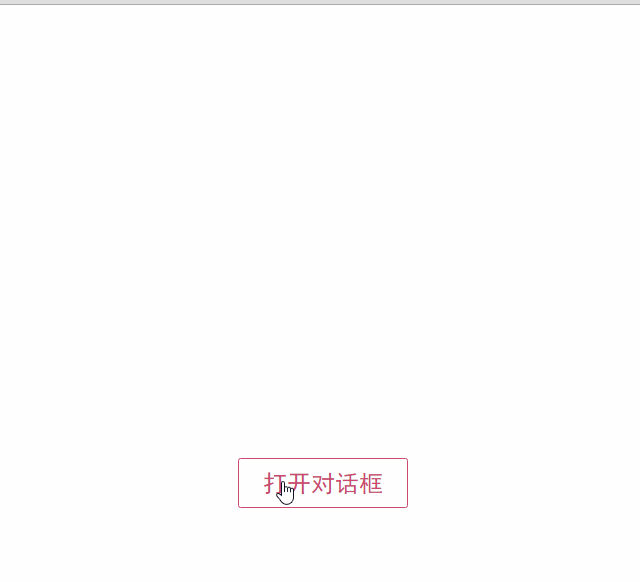
如果需要定制对话框的样式,我们只需要在<modal-dialog>上追加一个v-bind指令,让它绑定一个class。
<modal-dialog v-bind:show.sync=”show” v-bind:class=”dialogClass”>
然后修改一下Vue实例,在data选项中追加一个dialogClass属性,然后修改openDialog()方法:
new Vue({
el: ‘#app’,
data: {
show: false,
dialogClass: ‘dialog-info’
},
methods: {
openDialog: function(dialogClass) {
this.show = true
this.dialogClass = dialogClass
},
closeDialog: function() {
this.show = false
}
}
})
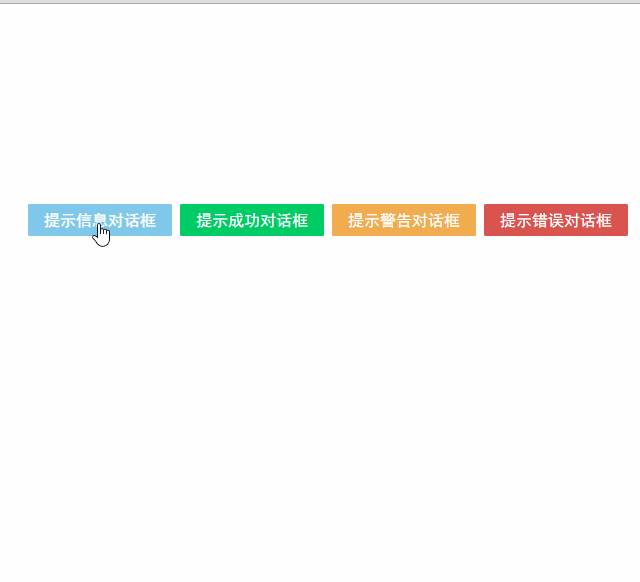
虽然我们在modal-dialog组件中定义了3个slot,但是在页面中使用它时,并不用每次都指定这3个slot。
比如,有时候我们可能只需要header和body:
<modal-dialog v-bind:show.sync="show" v-bind:class="dialogClass">
<header class="dialog-header" slot="header">
<h1 class="dialog-title">提示信息</h1>
</header>
<div class="dialog-body" slot="body">
<p>你想在对话框中放什么内容都可以!</p>
<p>你可以放一段文字,也可以放一些表单,或者是一些图片。</p>
</div>
</modal-dialog>
现在看到的对话框是没有底部的,只有标题和主体内容。
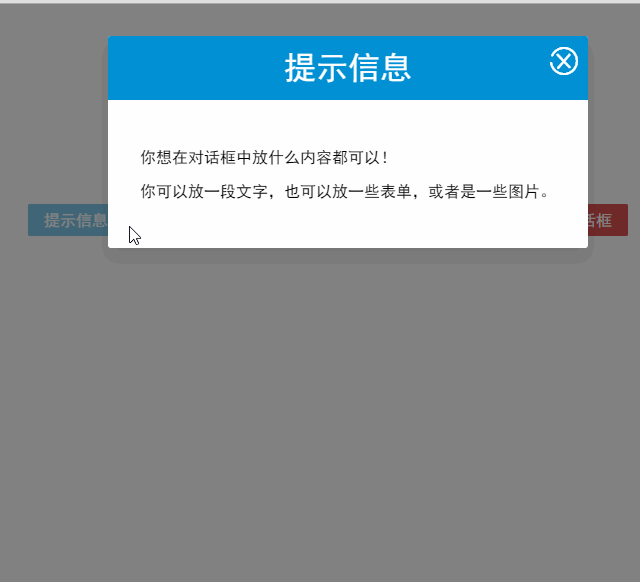
多个slot同时使用的场景还有很多,例如:用户的注册、登录、找回密码等这些表单集合,也可以用一个组件来完成。
父子组件之间的访问
有时候我们需要父组件访问子组件,子组件访问父组件,或者是子组件访问根组件。
针对这几种情况,Vue.js都提供了相应的API:
- 父组件访问子组件:使用$children或$refs
- 子组件访问父组件:使用$parent
- 子组件访问根组件:使用$root
$children示例
下面这段代码定义了3个组件:父组件parent-component,两个子组件child-component1和child-component2。
在父组件中,通过this.$children可以访问子组件。
this.$children是一个数组,它包含所有子组件的实例。
<div id="app">
<parent-component></parent-component>
</div>
<template id="parent-component">
<child-component1></child-component1>
<child-component2></child-component2>
<button v-on:click="showChildComponentData">显示子组件的数据</button>
</template>
<template id="child-component1">
<h2>This is child component 1</h2>
</template>
<template id="child-component2">
<h2>This is child component 2</h2>
</template>
<script src="js/vue.js"></script>
<script>
Vue.component(‘parent-component’, {
template: ‘#parent-component’,
components: {
‘child-component1’: {
template: ‘#child-component1’,
data: function() {
return {
msg: ‘child component 111111’
}
}
},
‘child-component2’: {
template: ‘#child-component2’,
data: function() {
return {
msg: ‘child component 222222’
}
}
}
},
methods: {
showChildComponentData: function() {
for (var i = 0; i < this.$children.length; i++) {
alert(this.$children[i].msg)
}
}
}
})
new Vue({
el: ‘#app’
})
</script>
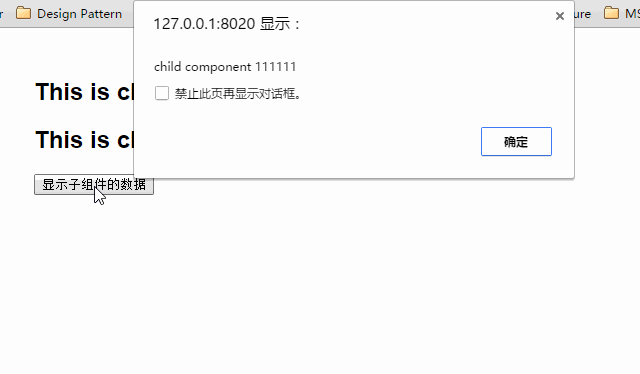
$refs示例
组件个数较多时,我们难以记住各个组件的顺序和位置,通过序号访问子组件不是很方便。
在子组件上使用v-ref指令,可以给子组件指定一个索引ID:
<template id="parent-component">
<child-component1 v-ref:cc1></child-component1>
<child-component2 v-ref:cc2></child-component2>
<button v-on:click="showChildComponentData">显示子组件的数据</button>
</template>
在父组件中,则通过$refs.索引ID访问子组件的实例:
showChildComponentData: function() {
alert(this.$refs.cc1.msg);
alert(this.$refs.cc2.msg);
}
$parent示例
下面这段代码定义了两个组件:child-component和它的父组件parent-component。
在子组件中,通过this.$parent可以访问到父组件的实例。
<div id="app">
<parent-component></parent-component>
</div>
<template id="parent-component">
<child-component></child-component>
</template>
<template id="child-component">
<h2>This is a child component</h2>
<button v-on:click="showParentComponentData">显示父组件的数据</button>
</template>
<script src="js/vue.js"></script>
<script>
Vue.component(‘parent-component’, {
template: ‘#parent-component’,
components: {
‘child-component’: {
template: ‘#child-component’,
methods: {
showParentComponentData: function() {
alert(this.$parent.msg)
}
}
}
},
data: function() {
return {
msg: ‘parent component message’
}
}
})
new Vue({
el: ‘#app’
})
</script>

注意:尽管可以访问父链上任意的实例,不过子组件应当避免直接依赖父组件的数据,尽量显式地使用 props 传递数据。另外,在子组件中修改父组件的状态是非常糟糕的做法,因为:
1.这让父组件与子组件紧密地耦合;
2. 只看父组件,很难理解父组件的状态。因为它可能被任意子组件修改!理想情况下,只有组件自己能修改它的状态。
自定义事件
有时候我们希望触发父组件的某个事件时,可以通知到子组件;触发子组件的某个事件时,可以通知到父组件。
Vue 实例实现了一个自定义事件接口,用于在组件树中通信。这个事件系统独立于原生 DOM 事件,用法也不同。
每个 Vue 实例都是一个事件触发器:
- 使用 $on() 监听事件;
- 使用 $emit() 在它上面触发事件;
- 使用 $dispatch() 派发事件,事件沿着父链冒泡;
- 使用 $broadcast() 广播事件,事件向下传导给所有的后代。
派发事件
下面这段代码是一个简单的事件派发处理
<div id="app">
<p>Messages: {{ messages | json }}</p>
<child-component></child-component>
</div>
<template id="child-component">
<input v-model="msg" />
<button v-on:click="notify">Dispatch Event</button>
</template>
<script src="js/vue.js"></script>
<script>
// 注册子组件
Vue.component(‘child-component’, {
template: ‘#child-component’,
data: function() {
return {
msg: ”
}
},
methods: {
notify: function() {
if (this.msg.trim()) {
this.$dispatch(‘child-msg’, this.msg)
this.msg = ”
}
}
}
})
// 初始化父组件
new Vue({
el: ‘#app’,
data: {
messages: []
},
events: {
‘child-msg’: function(msg) {
this.messages.push(msg)
}
}
})
</script>
我们将这个示例分为几个步骤解读:
- 子组件的button元素绑定了click事件,该事件指向notify方法
- 子组件的notify方法在处理时,调用了$dispatch,将事件派发到父组件的child-msg事件,并给该该事件提供了一个msg参数
- 父组件的events选项中定义了child-msg事件,父组件接收到子组件的派发后,调用child-msg事件。
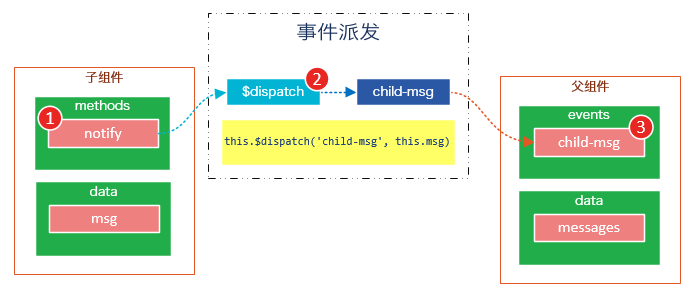
运行结果如下:
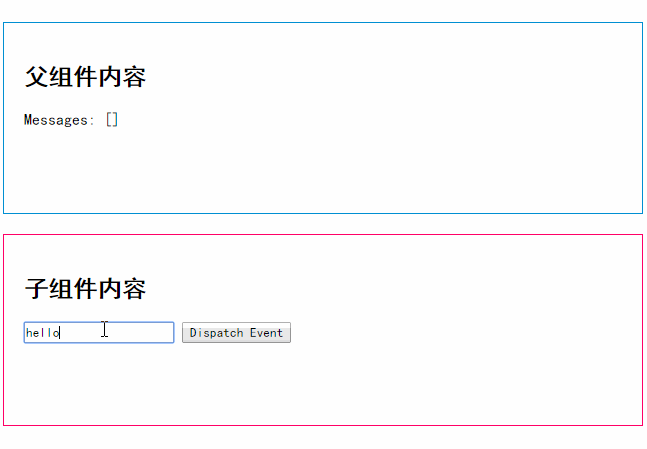
广播事件
下面这段代码是一个简单的事件广播处理
<div id="app">
<input v-model="msg" />
<button v-on:click="notify">Broadcast Event</button>
<child-component></child-component>
</div>
<template id="child-component">
<ul>
<li v-for="item in messages">
父组件录入了信息:{{ item }}
</li>
</ul>
</template>
<script src="js/vue.js"></script>
<script>
// 注册子组件
Vue.component(‘child-component’, {
template: ‘#child-component’,
data: function() {
return {
messages: []
}
},
events: {
‘parent-msg’: function(msg) {
this.messages.push(msg)
}
}
})
// 初始化父组件
new Vue({
el: ‘#app’,
data: {
msg: ”
},
methods: {
notify: function() {
if (this.msg.trim()) {
this.$broadcast(‘parent-msg’, this.msg)
}
}
}
})
</script>
我们将这个示例分为几个步骤解读:
- 父组件的button元素绑定了click事件,该事件指向notify方法
- 父组件的notify方法在处理时,调用了$broadcast,将事件派发到子组件的parent-msg事件,并给该该事件提供了一个msg参数
- 子组件的events选项中定义了parent-msg事件,子组件接收到父组件的广播后,调用parent-msg事件。
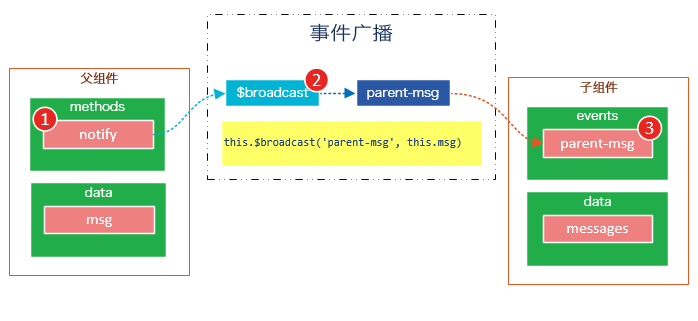
运行结果如下:
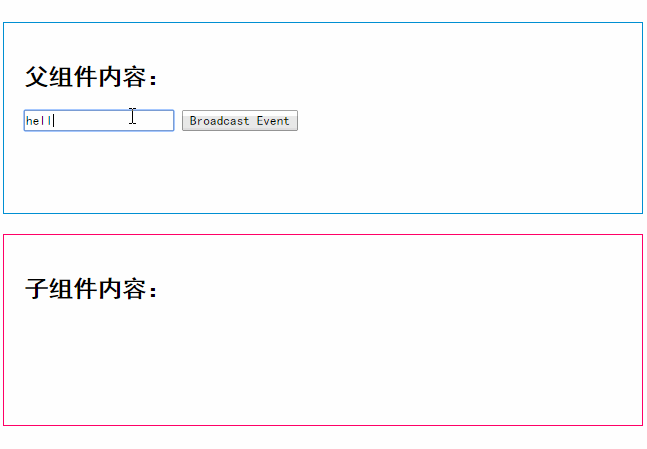
CURD示例
Vue.js组件的API来源于三部分——prop,slot和事件。
-
prop 允许外部环境传递数据给组件;
-
事件 允许组件触发外部环境的 action;
-
slot 允许外部环境插入内容到组件的视图结构内。
至此,这三部分我都已经介绍完了,接下来我就用这些知识来教大家一步一步完成一个CURD示例。
第1步——创建表格组件,添加查询和删除功能
创建表格组件,添加过滤,数据删除功能
<div id="app">
<div class="container">
<div class="form-group">
<label>Search</label>
<input type="text" class="search-input" v-model="searchQuery" />
</div>
</div>
<div class="container">
<simple-grid :data-list="people" :columns="columns" :search-key="searchQuery">
</simple-grid>
</div>
</div>
<template id="grid-template">
<table>
<thead>
<tr>
<th v-for="col in columns">
{{ col.name | capitalize}}
</th>
<th>
Delete
</th>
</tr>
</thead>
<tbody>
<tr v-for="(index,entry) in dataList | filterBy searchKey">
<td v-for="col in columns">
{{entry[col.name]}}
</td>
<td class="text-center">
<button @click="deleteItem(index)">delete</button>
</td>
</tr>
</tbody>
</table>
</template>
<script src="../js/vue.js"></script>
<script>
Vue.component(‘simple-grid’, {
template: ‘#grid-template’,
props: [‘dataList’, ‘columns’, ‘searchKey’],
methods: {
deleteItem: function(index) {
this.dataList.splice(index, 1);
},
}
})
var demo = new Vue({
el: ‘#app’,
data: {
searchQuery: ”,
columns: [{
name: ‘name’
}, {
name: ‘age’
}, {
name: ‘sex’
}],
people: [{
name: ‘Jack’,
age: 30,
sex: ‘Male’
}, {
name: ‘Bill’,
age: 26,
sex: ‘Male’
}, {
name: ‘Tracy’,
age: 22,
sex: ‘Female’
}, {
name: ‘Chris’,
age: 36,
sex: ‘Male’
}]
}
})
</script>
![20[3] 20[3]](http://images2015.cnblogs.com/blog/341820/201607/341820-20160703121643359-73772709.gif)
使用知识点
1. 使用Vue.component语法糖
Vue.component是创建并注册组件的语法糖,使用Vue.component注册的组件是全局的。
2. 使用prop将父组件数据传递给子组件
#app元素是父组件,simple-grid是子组件。
在simple-grid组件中定义选项props: [‘dataList’, ‘columns’, ‘searchKey’]
在#app下使用<simple-grid :data-list=”people” :columns=”columns” :search-key=”searchQuery”> 将数据传递给simple-grid组件
3. 使用过滤器
{{ col.name | capitalize}}使用了capitalize过滤器,将字符串的首字母转换为大写后输出。
filterBy filterKey使用了filterBy过滤器,根据指定条件过滤数组元素,filterBy返回过滤后的数组。
4. 使用数组索引别名
数组默认的索引名称为$index,v-for=”(index,entry) in dataList使用了数组索引别名。
括号中的第一个参数index是$index的别名,第二个参数是遍历的数组元素。
5. 使用了v-bind和v-on指令的缩写
<simple-grid :data-list=”people” :columns=”columns” :search-key=”searchQuery”> 使用了v-bind指令的缩写。
:data-list是v-bind:data-list的缩写,:columns是v-bind:columns的缩写,:search-key是v-bind:search-key的缩写。
<button @click=”deleteItem(index)”>delete</button> 使用了v-on指令的缩写,@click是v-on:click的缩写。
第2步——创建对话框组件
表格数据的添加和修改,我们使用模态对话框来实现。
模态对话框有两种模式,新建模式和修改模式,分别用于新建一条数据和修改指定的数据。
由于对话框的内容来源于具体的数据,所以我们可以考虑将对话框作为simple-grid组件的一个子组件。
modal-dialog组件的模板内容:
<template id="dialog-template">
<div class="dialogs">
<div class="dialog" v-bind:class="{ ‘dialog-active’: show }">
<div class="dialog-content">
<header class="dialog-header">
<h1 class="dialog-title">{{ title }}</h1>
</header>
<footer class="dialog-footer">
<div class="form-group">
<label></label>
<button v-on:click="save">Save</button>
<button v-on:click="close">Close</button>
</div>
</footer>
</div>
</div>
<div class="dialog-overlay"></div>
</div>
</template>
modal-dialog组件在simple-grid组件中注册:
Vue.component(‘simple-grid’, {
// …已省略
data: function() {
return {
mode: 0,
item: {}
}
},
components: {
‘modal-dialog’: {
template: ‘#dialog-template’,
data: function() {
return {
// 对话框默认是不显示的
show: false
}
},
/*
* mode = 1是新增数据模式,mode = 2是修改数据模式
* title表示对话框的标题内容
* fields表示对话框要显示的数据字段数组
* item是由simple-dialog传下来,用于绑定表单字段的
*/
props: [‘mode’, ‘title’, ‘fields’, ‘item’],
methods: {
close: function() {
this.show = false
},
save: function() {
}
}
}
}
// …已省略
})
由于modal-dialog组件是simple-grid的子组件,所以它应该在simple-grid的template中使用:
<template id="grid-template">
<!–…前面的内容已省略 –>
<modal-dialog :mode="mode" :title="title" :fields="columns" :item="item">
</modal-dialog>
<!–…后面的内容已省略 –>
</template>
modal-dialog组件的props选项,追加了3个元素:
- title表示对话框的标题内容
- fields表示对话框要显示的数据字段数组
- item用于绑定表单字段,它是一个对象
注意:由于modal-dialog是一个子组件,它仅用于simple-grid组件的新增或修改模式,所以modal-dialog的template没有使用<slot>元素
使用知识点
1. 使用组件的局部注册
modal-dialog组件没有使用Vue.component进行全局注册,使用simple-grid组件components选项实现了局部注册。
2. 使用组件的data选项
组件的data选项必须以函数的方式返回。
第3步——实现数据新建功能
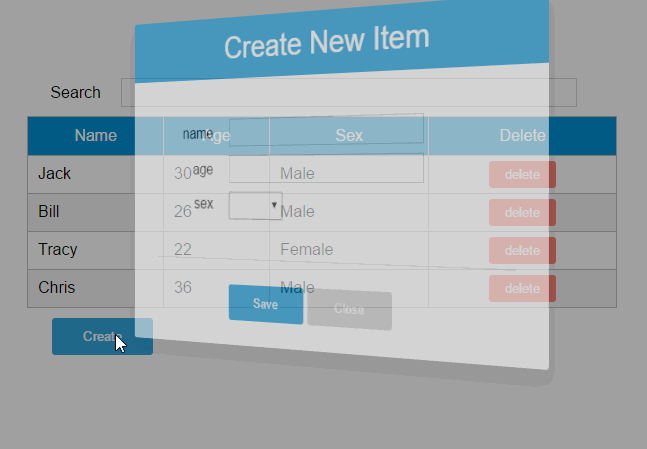
1. 修改Vue实例的data选项的columns:
var demo = new Vue({
// …已省略
columns: [{
name: ‘name’,
isKey: true
}, {
name: ‘age’
}, {
name: ‘sex’,
dataSource: [‘Male’, ‘Female’]
}]
// …已省略
})
为’name’列追加一个isKey属性,并设置为true,表示该列为主键列。
为’sex’列追加一个dataSoruce属性,并设置为[‘Male’, ‘Female’],表示新增或修改数据时选择性别的下拉框数据源。
2. 修改modal-dialog的template:
<template id="dialog-template">
<div class="dialogs">
<div class="dialog" v-bind:class="{ ‘dialog-active’: show }">
<div class="dialog-content">
<header class="dialog-header">
<h1 class="dialog-title">{{ title }}</h1>
</header>
<div v-for="field in fields" class="form-group" >
<label>{{ field.name }}</label>
<select v-if="field.dataSource" v-model="item[field.name]">
<option v-for="opt in field.dataSource" :value="opt">{{ opt }}</option>
</select>
<input v-else type="text" v-model="item[field.name]">
</div>
<footer class="form-group">
<label></label>
<button v-on:click="save">Save</button>
<button v-on:click="close">Close</button>
</footer>
</div>
</div>
<div class="dialog-overlay"></div>
</div>
</template>
在modal-dialog组件的模板中遍历fields,然后显示field的名称。
在渲染表单时,根据是否有dataSource判定表单是下拉框还是文本框。
(由于示例较为简陋,所以只提供了input和select两种表单类型)
注意modal-dialog组件的fields是由Vue实例传递给simple-grid,然后再由simple-grid传递过来的。
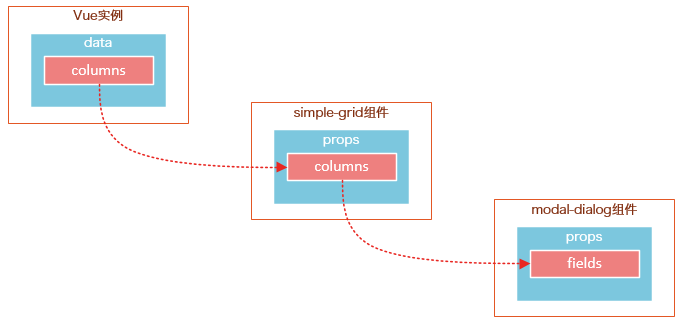
3. 修改simple-grid的template
<template id="grid-template">
<!–…已省略 –>
<div class="container">
<button class="btn" @click="openNewItemDialog(‘Create new item’)">Create</button>
</div>
<modal-dialog :mode="mode" :title="title" :fields="columns" :item="item" v-on:create-item="createItem">
</modal-dialog>
</template>
添加一个Create按钮,绑定click事件到openNewItemDiaolog()方法,该方法用于打开modal-dialog组件,并将模式设置为新建模式。
在<modal-dialog>标签上给sample-grid绑定一个自定义事件create-item,后面在$dispatch派发事件时会用到。
4. 修改simple-grid的methods选项
Vue.component(‘simple-grid’, {
// …已省略
methods: {
openNewItemDialog: function(title) {
// 对话框的标题
this.title = title
// mode = 1表示新建模式
this.mode = 1
// 初始化this.item
this.item = {}
// 广播事件,showDialog是modal-dialog组件的一个方法,传入参数true表示显示对话框
this.$broadcast(‘showDialog’, true)
},
createItem: function() {
// 将item追加到dataList
this.dataList.push(this.item)
// 广播事件,传入参数false表示隐藏对话框
this.$broadcast(‘showDialog’, false)
// 新建完数据后,重置item对象
this.item = {}
},
deleteItem: function(index) {
this.dataList.splice(index, 1);
},
},
// …已省略
})
追加了两个方法:opeNewItemDialog和createItem方法。
opeNewItemDialog方法用于打开对话框,this.$broadcast(‘showDialog’, true) 调用子组件modal-dialog的showDialog事件,传入参数true表示显示对话框。
createItem方法用于保存新建的数据,this.$broadcast(‘showDialog’, false) 调用子组件modal-dialog的showDialog事件,传入参数false表示隐藏对话框。
5. 修改modal-grid的methods和events选项
Vue.component(‘simple-grid’, {
// …已省略
components: {
‘modal-dialog’: {
// …已省略
methods: {
close: function() {
this.show = false
},
save: function() {
//新建模式
if (this.mode === 1){
// 使用$dispatch调用simple-grid的create-item方法
this.$dispatch(‘create-item’)
}
}
},
events: {
// 显示或隐藏对话框
‘showDialog’: function(show) {
this.show = show
}
}
}
}
// …已省略
})
修改methods选项的save方法,由于保存按钮是在子组件modal-dialog中的,而createItem方法是在父组件simple-grid中的,所以这里使用this.$dispatch(‘create-item’) 派发到父组件的自定义事件create-item。
追加events选项,添加showDialog事件,用于显示或隐藏对话框。
请将4和5结合起来看,我们既用到了$broadcast广播事件,又用到了$dispatch派发事件。
下面这幅图有助于理解simple-grid和modal-dialog组件之间的通信:
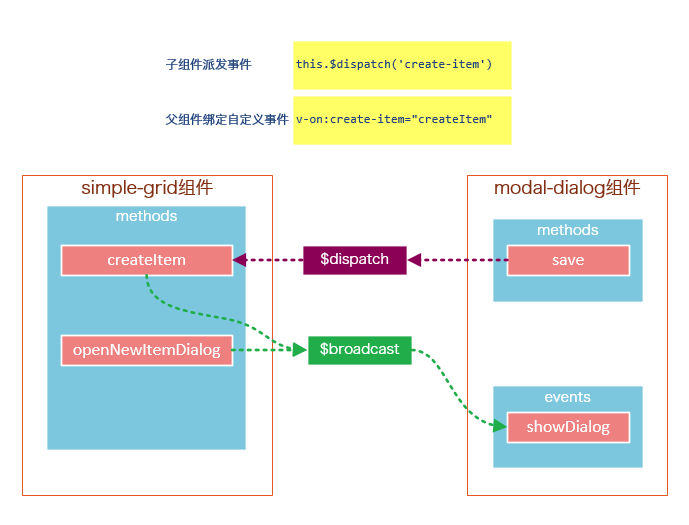
create-item是一个自定义事件,由子组件modal-dialog调用this.$dispatch(‘create-item’) 派发到自定义事件create-item,自定义事件create-item是绑定在父组件simple-grid上的,该事件会执行createItem方法。
第4步——实现数据修改功能
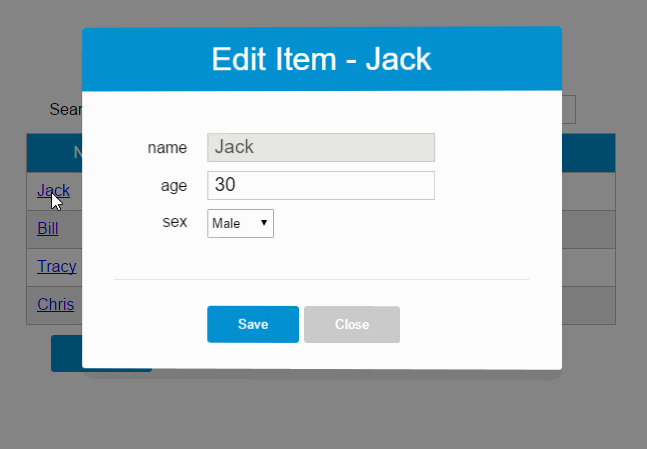
1. 修改sample-grid的template
<template id="grid-template">
<!–…已省略–>
<tbody>
<tr v-for="(index,entry) in dataList | filterBy searchKey">
<td v-for="col in columns">
<span v-if="col.isKey"><a href="javascript:void(0)" @click="openEditItemDialog(index, ‘Edit item ‘ + entry[col.name])">{{entry[col.name]}}</a></span>
<span v-else>{{entry[col.name]}}</span>
</td>
</tr>
</tbody>
<!–…已省略–>
<modal-dialog
:mode="mode"
:title="title"
:item="item"
:fields="columns"
v-on:create-item="createItem"
v-on:update-item="updateItem">
</modal-dialog>
</template>
遍历列表数据时,使用v-if指令判断当前列是否为主键列,如果是主键列,则给主键列添加链接,然后给链接绑定click事件,click事件用于打开修改数据的对话框。
在<modal-dialog>标签上,给sample-grid绑定自定义事件update-item,update-item事件指向sample-grid的方法updateItem。
2. 修改modal-dialog的template
<div v-for="field in fields" class="form-group">
<label>{{ field.name }}</label>
<select v-if="field.dataSource" v-model="item[field.name]" :disabled="mode === 2 && field.isKey">
<option v-for="opt in field.dataSource" :value="opt">{{ opt }}</option>
</select>
<input v-else type="text" v-model="item[field.name]" :disabled="mode === 2 && field.isKey">
</div>
在修改模式下(mode = 2),如果当前字段是主键字段,则禁止修改。
3. 修改sample-grid的methods选项
// 弹出修改数据的对话框时,使用对象的深拷贝
initItemForUpdate: function(p) {
var c = c || {};
for (var i in p) {
// 属性i是否为p对象的自有属性
if (p.hasOwnProperty(i)) {
if (typeof p[i] === ‘object’) {
c[i] = Array.isArray(p[i]) ? [] : {}
deepCopy(p[i], c[i])
} else {
// 属性是基础类型时,直接拷贝
c[i] = p[i]
}
}
}
return c;
},
findItemByKey: function(key){
var keyColumn = this.keyColumn
for(var i = 0; i < this.dataList.length; i++){
if(this.dataList[i][keyColumn] === key){
return this.dataList[i]
}
}
},
createItem: function() {
// 将item追加到dataList
this.dataList.push(this.item)
// 广播事件,传入参数false表示隐藏对话框
this.$broadcast(‘showDialog’, false)
// 新建完数据后,重置item对象
this.item = {}
},
updateItem: function() {
// 获取主键列
var keyColumn = this.keyColumn
for (var i = 0; i < this.dataList.length; i++) {
// 根据主键查找要修改的数据,然后将this.item数据更新到this.dataList[i]
if (this.dataList[i][keyColumn] === this.item[keyColumn]) {
for (var j in this.item) {
this.dataList[i][j] = this.item[j]
}
break;
}
}
// 广播事件,传入参数false表示隐藏对话框
this.$broadcast(‘showDialog’, false)
// 修改完数据后,重置item对象
this.item = {}
}
追加的内容:调用内置的ready()函数,openEditDialog、updateItem、findItemByKey和initItemForUpdate方法。
ready()函数会在编译结束和$el 第一次插入文档之后调用,你可以将其理解为jQuery中的document.ready()。
在ready()函数中,初始化keyColumn,keyColumn表示主键列,调用updateItem方法时,会根据主键数据找到dataList中匹配的元素。
opeEditItemDialog方法用于打开对话框,this.$broadcast(‘showDialog’, true) 调用子组件modal-dialog的showDialog事件,传入参数true表示显示对话框。
ready()函数没有特别的业务逻辑,主要是获取主键列,调用updateItem方法时,会根据主键数据找到dataList中匹配的元素。
updateItem方法用于保存修改的数据,this.$broadcast(‘showDialog’, false) 调用子组件modal-dialog的showDialog事件,传入参数false表示隐藏对话框。
initItemForUpdate方法用于将选中的数据this.dataList[index]深拷贝到this.item。为什么要使用深拷贝呢?因为this.dataList[index]是一个引用对象,它有一些属性也是引用类型的,如果使用浅拷贝可能得到一些超出预期的效果。
4.修改modal-dialog的methods选项
save: function() {
//新建模式
if (this.mode === 1) {
// 使用$dispatch调用simple-grid的create-item事件
this.$dispatch(‘create-item’)
}else if(this.mode === 2){
// 使用$dispatch调用simple-grid的update-item事件
this.$dispatch(‘update-item’)
}
}
修改methods选项中的save方法,this.mode === 2时,将事件派发到父组件的update-item事件。
第5步——修改数据新建功能
修改sample-grid的methods选项,追加itemExists方法,然后修改createItem方法。
itemExists: function(keyColumn) {
for (var i = 0; i < this.dataList.length; i++) {
if (this.item[keyColumn] === this.dataList[i][keyColumn])
return true;
}
return false;
},
createItem: function() {
var keyColumn = this.getKeyColumn()
if (!this.itemExists(keyColumn)) {
// 将item追加到dataList
this.dataList.push(this.item)
// 广播事件,传入参数false表示隐藏对话框
this.$broadcast(‘showDialog’, false)
// 新建完数据后,重置item对象
this.item = {}
} else {
alert(keyColumn + ‘ "’ + this.item[keyColumn] + ‘" is already exists’)
}
}
由于主键列数据是不能重复的,所以在新增数据时需要判断主键列数据是否已经存在。
总结
说到底,组件的API主要来源于以下三部分:
- prop 允许外部环境传递数据给组件;
- 事件 允许组件触发外部环境的 action;
- slot 允许外部环境插入内容到组件的视图结构内。
这三大知识点在上下两篇文章中都体现出来了,限于篇幅和个人知识的匮乏,我并不能将组件的所有特性都描述出来,这还需要靠各位花一些时间去多多了解官网的API,并付诸实践。
如果要构建一些大型的应用,基于组件的开发模式是一个不错的选择,我们将整个系统拆分成一个一个小组件,就像乐高一样,然后将这些组件拼接起来。
未经允许不得转载:爱前端网 » Vue.js——60分钟组件快速入门

 爱前端网
爱前端网
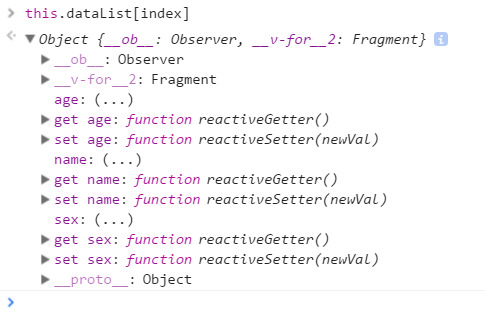

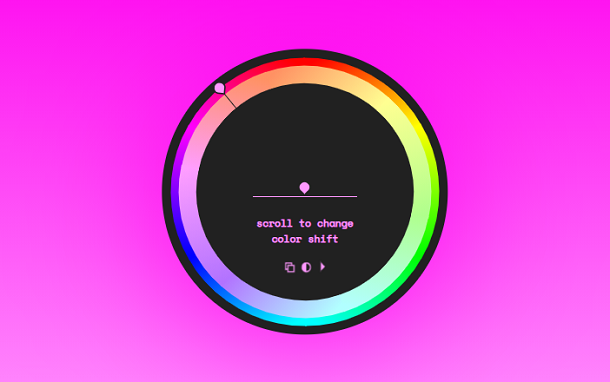 Vue.js 圆形CSS3渐变色拾取器
Vue.js 圆形CSS3渐变色拾取器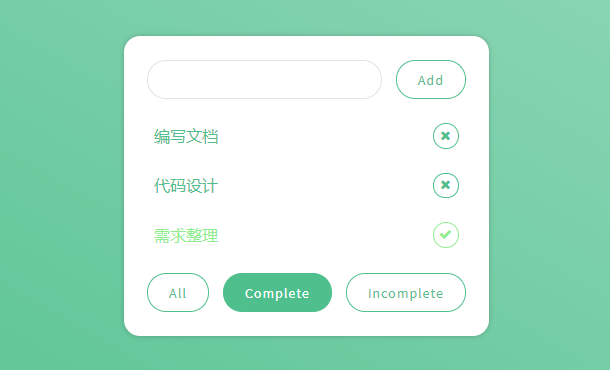 Vue.js任务列表 可本地存储任务数据
Vue.js任务列表 可本地存储任务数据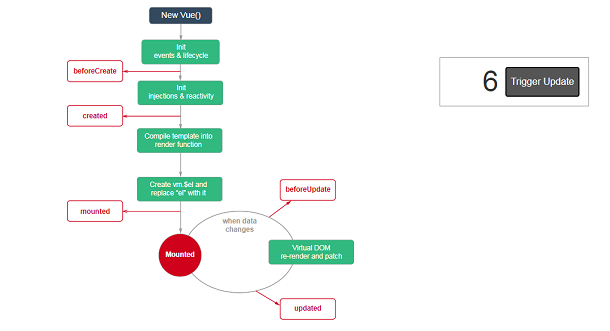 Vue.js流程图插件 可自定义流程节点事件
Vue.js流程图插件 可自定义流程节点事件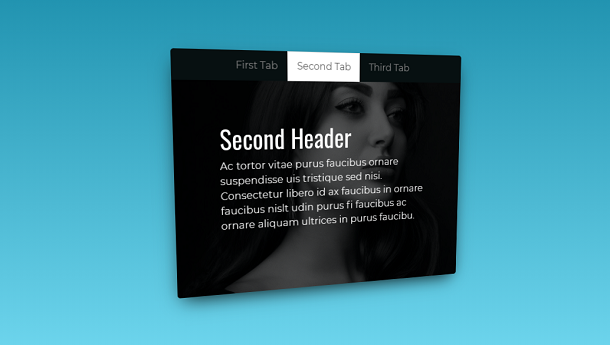 Vue.js实现的3D Tab菜单
Vue.js实现的3D Tab菜单 Vue.js折线图表插件 支持数据分组统计
Vue.js折线图表插件 支持数据分组统计 HTML5 3D地球仪 可按经纬坐标定位
HTML5 3D地球仪 可按经纬坐标定位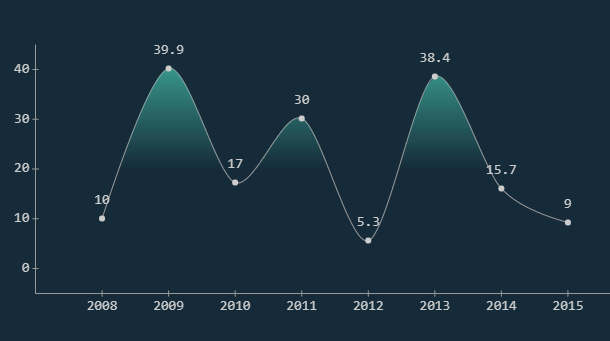 JavaScript 动画折线图 带阴影 3D 效果
JavaScript 动画折线图 带阴影 3D 效果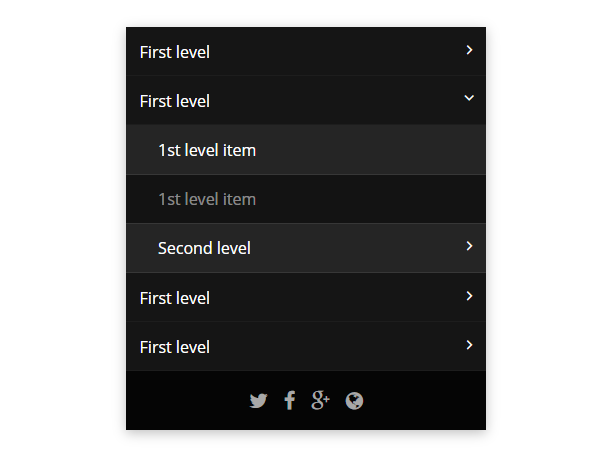 纯CSS3实现的无限级垂直手风琴菜单
纯CSS3实现的无限级垂直手风琴菜单 基于Splitting.js的CSS3魔幻文字动画特效
基于Splitting.js的CSS3魔幻文字动画特效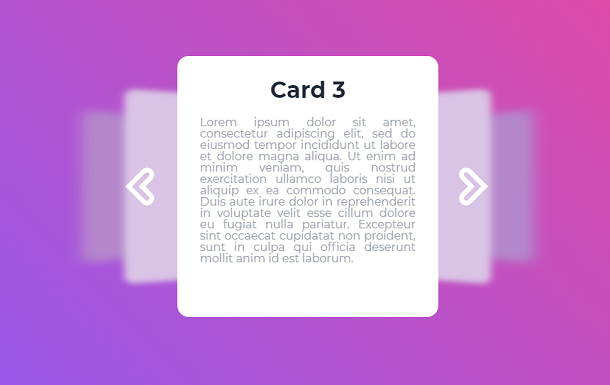 React 3D层叠卡片切换动画
React 3D层叠卡片切换动画 SVG带小图标的Checkbox美化插件
SVG带小图标的Checkbox美化插件
